As the last game day of the Champions League kicked off this week, a few teams were still uncertain of their future in this competition and even in Europe. With Bayern Munich topping group A, two of those teams were RB Salzburg and Atletico Madrid. Both teams could still qualify for the next round in Europe’s greatest competition, as Salzburg collected a total of five points and Atletico Madrid had seven points. With a win, Salzburg could send Atletico to the Europa League, anything less meant that the Spanish side would qualify to the next round in the Champions League.
With this in mind, the game was set up to be a nervous battle between two sides who are tactically well drilled. In this tactical analysis, we will take a look at the tactics from Jesse Marsch and Diego Simeone. As will this analysis give an insight into how both coaches tried to outwit each other.
Lineups and formations
Last game between both teams ended in a 3-2 win to the Spanish giants. Which led to a change of formation by Salzburg head coach. He chose to line his team up in a 4-4-2 diamond formation instead of the 4-2-3-1 used in the last encounter. This meant that only one change was made in personal. Midfielder Mohamed Camara was swapped out for Sékou Koïta, who partnered Patson Daka upfront.

Atletico Madrid on the other hand lined up in what many consider their best possible 11. Diego Simeone changed two positions from the previous game against Salzburg. Using their well known 4-4-2 flat, Simeone switched out Hector Herrera and Ángel Correa for Saùl Niguez and former Ligue 1 winger Yannick Carrasco.
Salzburg’s urgency
It was the home side who needed the three points thus from the first minute their play was full intensity by pressing the opponents high and constantly putting Madrid’s defence under pressure. This was the reason why Jan Oblak only played two short passes and opted to play all goal kicks long.
Pressing high up the field without structure and with a lack of organization leads to the opponent easily progressing through the thirds. As mentioned above Salzburg changed their formation to a 4-4-2 diamond. In order to understand why Salzburg changed their formation, we have to look back to my previous game analysis between both sides. The previous game Salzburg opted to press in a 4-2-3-1 system.
During this game frailties easily popped up in this organization. The striker would perform a curved run to the ball carrying centre-back which forced Atletico to one side. And with the Salzburg winger performing a cover shadow on the full-back, the Atletico centre-back had to play centrally to players occupying the space between the lines. But because Atleti overloaded this area, the free Atletico player could play a bounce pass to the full-back nullifying the cover shadow on him. Thus Atletico could progress smoothly and this caused the change.
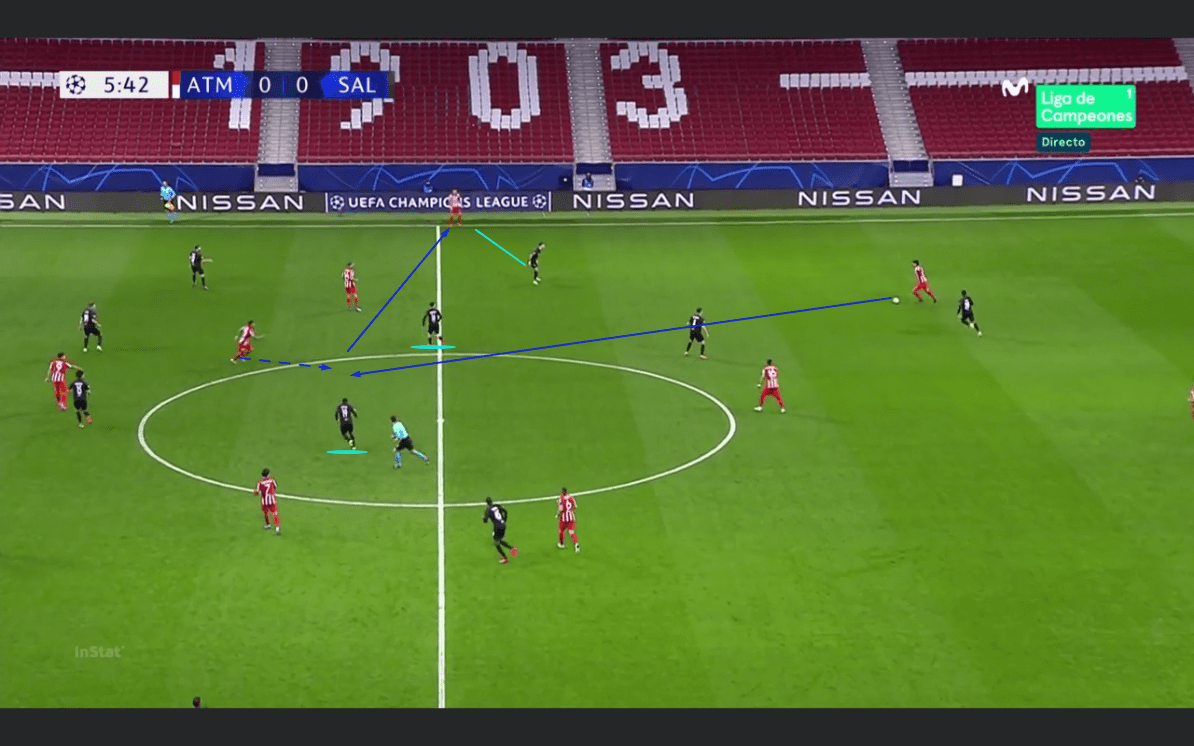
The change of formation was successful as Salzburg were able to win the back more often. The image below shows how they did it. Once the ball was in possession of one of the outside centre-backs, Mario Hermoso moved inside to form a back three in the possession phase, the ball near striker would press him with a curved run, forcing him to pass to the side. As would the attacking midfielder mark the pivot and the ball far striker would mark the central centre-back. This time the pass to the full-back was left open and once the pass to the full-back, a wide Salzburg midfielder positioned himself between an Atletico midfielder and full-back, ready to intercept. Emphasizing one of their key principles: always start the press when the ball is played, not when it has already arrived.
If the full-back or midfielder could receive Rasmus Kristensen would step out to cover the free man on the side, creating an equality.
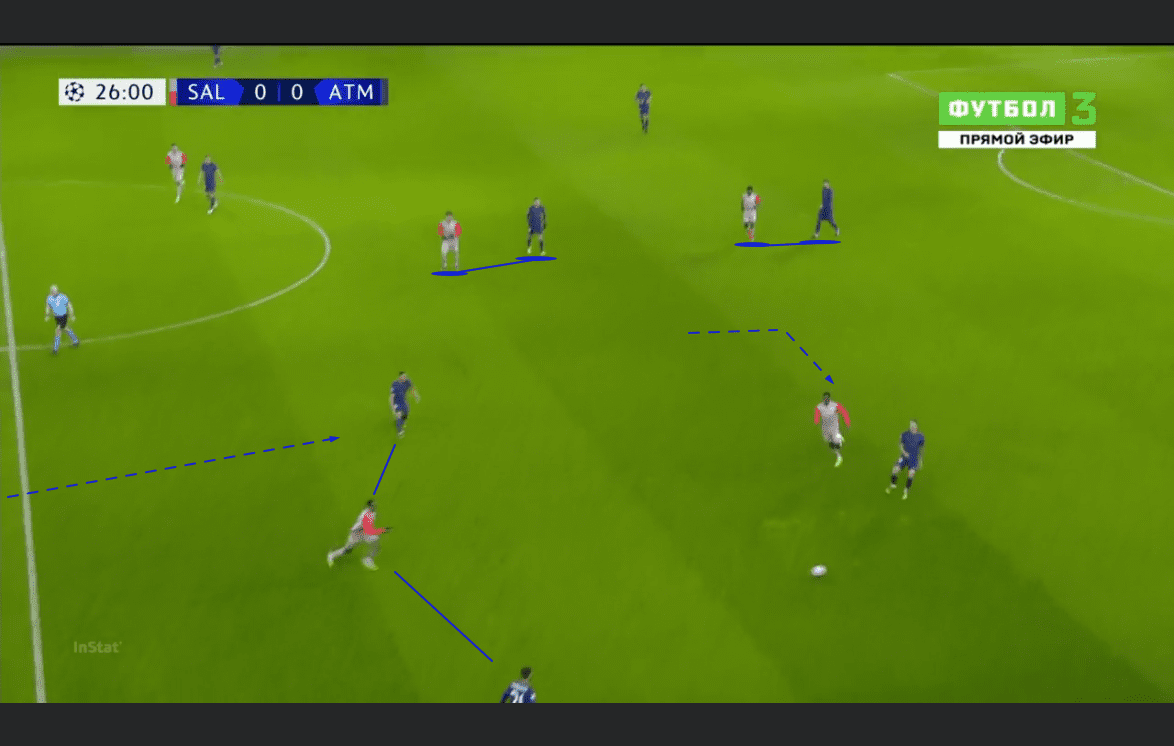
The image below gives a more structured view. Thus when pressing Atletico, the away side didn’t find a clear solution and opted to play the long ball into Salzburg’s last line, only to lose the ball again as they had a numerical superiority in this area.
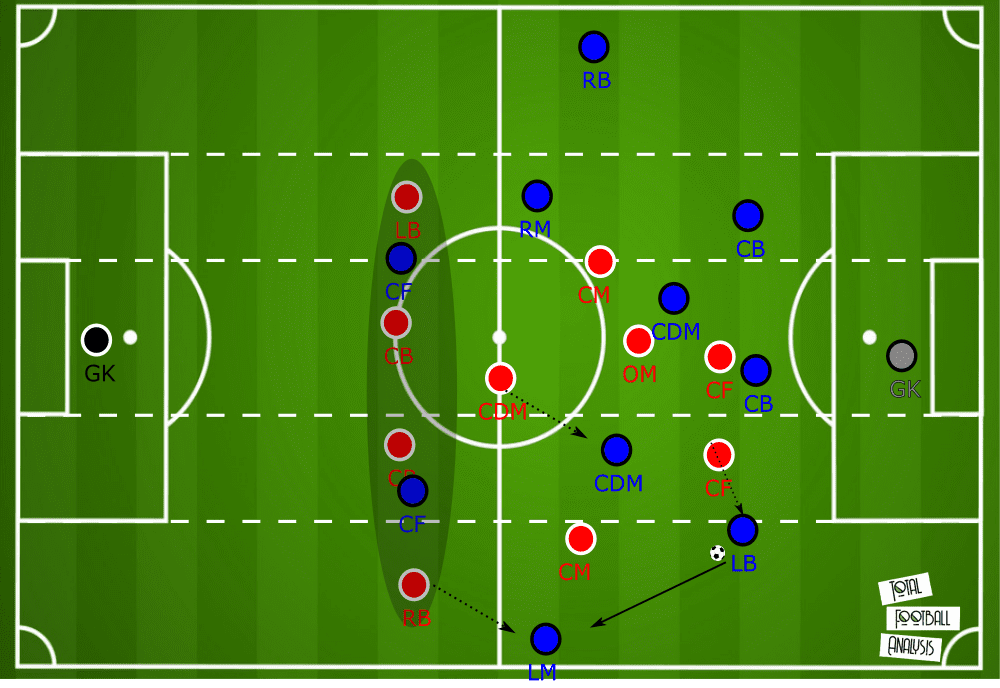
Atletico tried to play neatly through thirds but due to Salzburg’s pressing, they eventually used more long passes. This caused for a game that went from end to end. Both teams didn’t show long spells of possession.
This played into the hands of Salzburg as the game opened up more. Beneath we can see how Salzburg tried to profit from these moments. Once the ball was won back, the home side tried to get as quick as possible to the opponent’s goal. By playing vertical passes in behind, one of two strikers already in advanced areas tried to attack the half-spaces. With the other running players making a run to the penalty area, attacking the first and the pull-back zone. Salzburg would cross the ball time and time again low because Marsch prefers to use low crosses during the transition moments, as deflections could cause more problems if the ball doesn’t find an attacker.
Another key principle during transition is also the runs from the defenders’ blindside. Here Daka makes a run from Stefan Savić blindside to arrive in the box to the first post, causing a surprise effect.
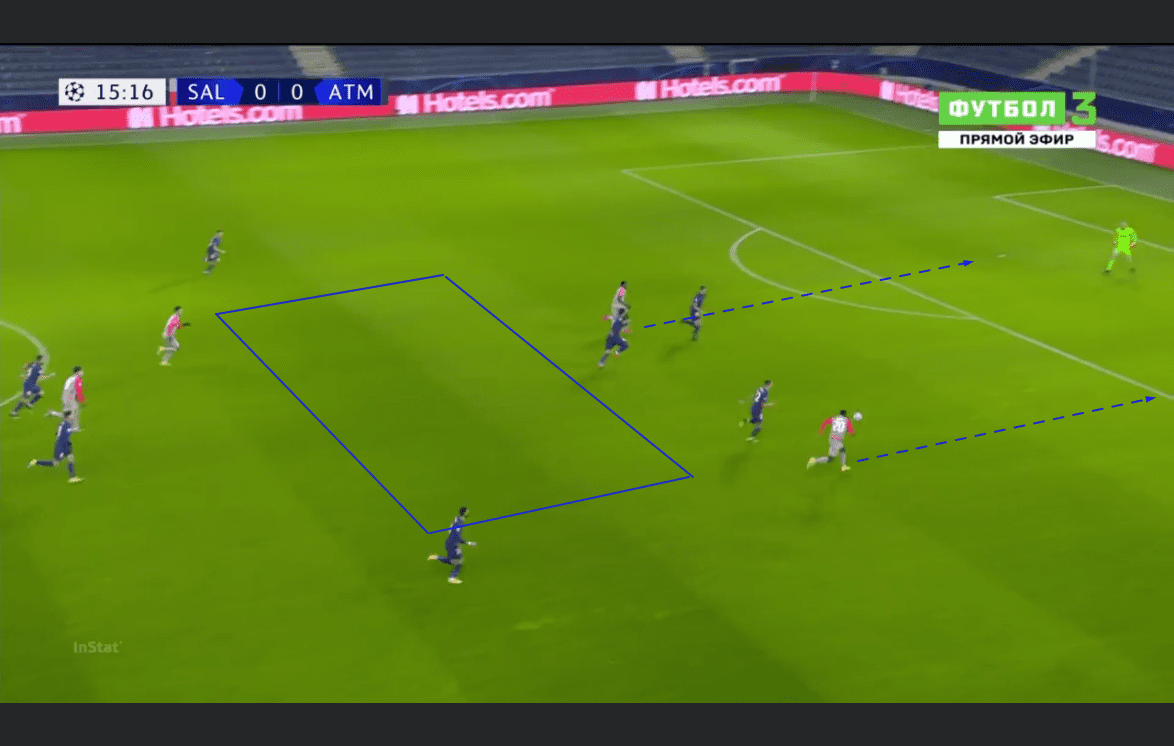
Here again, Kristensen receives the ball from the centre-back and pushes it down the line. What follows is him making an unnatural, curved run in behind whilst Carrasco stepped out and turned his head to watch the ball. This again causes the surprise effect as Carrasco will realize too late that his marker has run in behind.
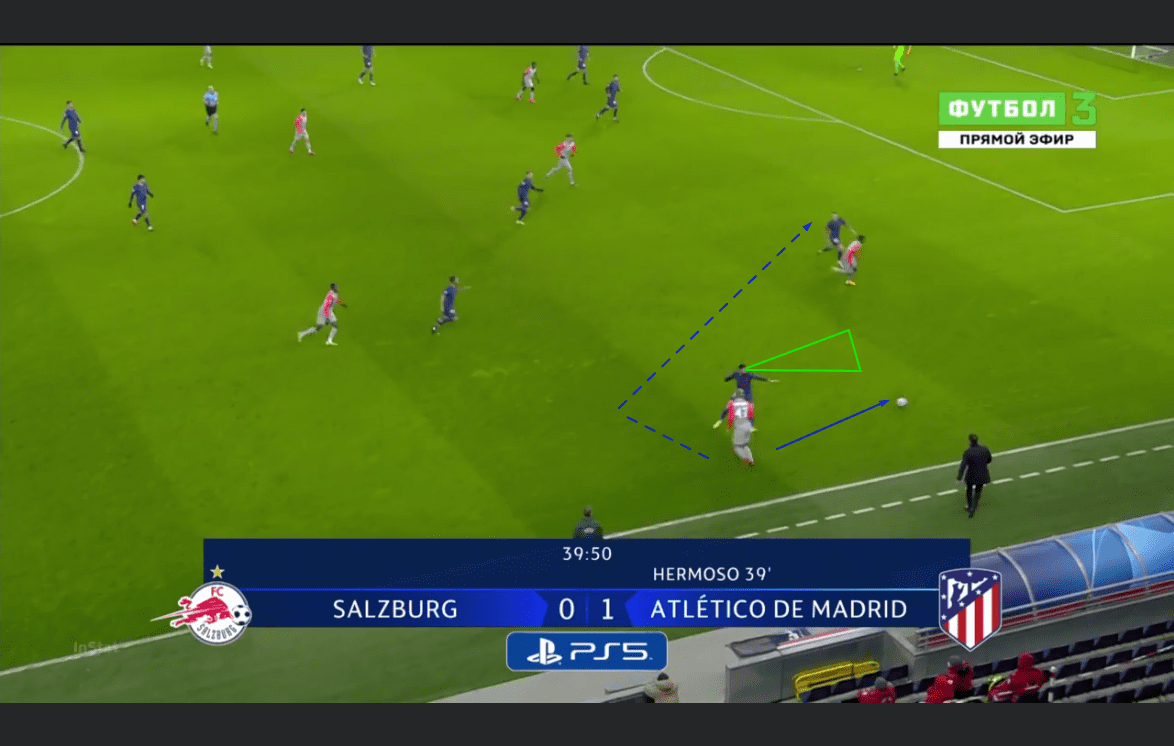
Another note that has to be made, is that of the numerous transitional moments created chaos centrally. Consequently, the home side would often lose the ball in these areas. Using the full width of the pitch would stretch the away side horizontally and create space centrally between each individual player. This also allowing more switches of play, as the outside players would create more space to receive without pressure. And eventually, it would cause problems for the opposing defenders as they cannot see the ball and the attackers at the same time.
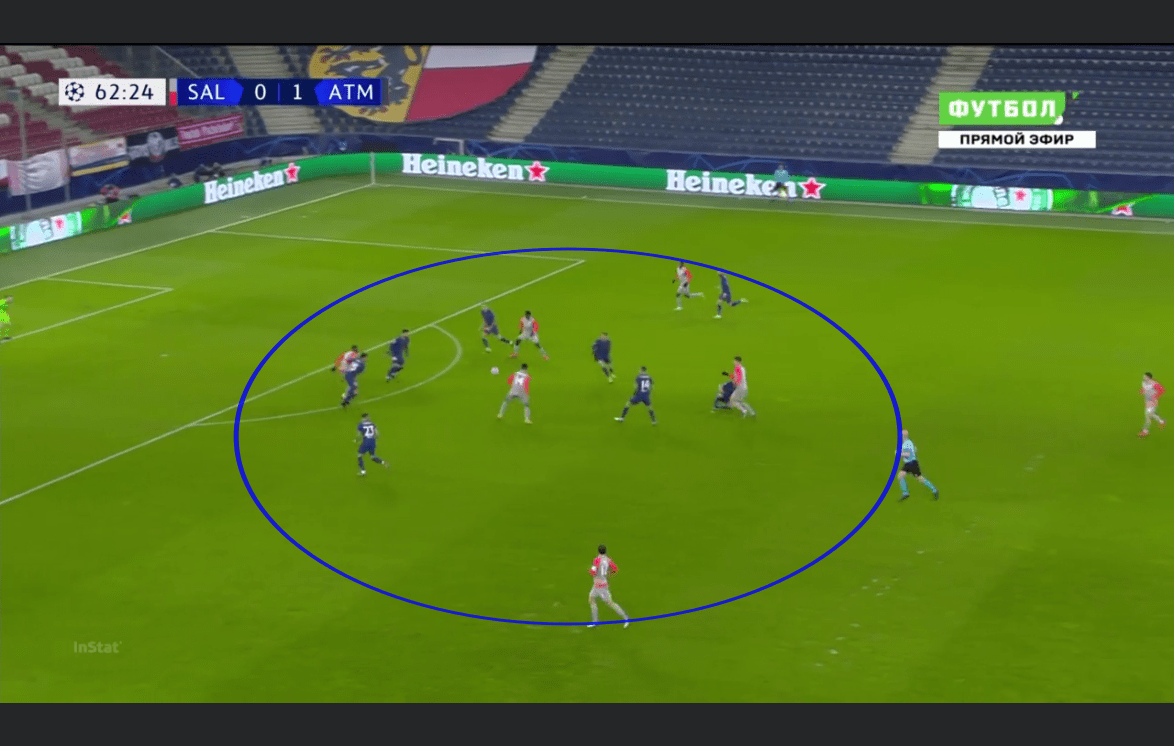
Salzburg taking the initiative
As the home side pressed at every opportunity possible, they would eventually win the ball back and have to break down Atletico’s low block, who were happy to stay in a medium to low block and wait for Salzburg to force the play. Marsch had counted on that and worked out a formula to try and break down Simeone’s men.
Starting with a wide rotation that would cause decisional problems for Atletico’s block. The two strikers of the away side would only look to cut direct passes to Salzburg’s pivot. Thus mostly Enock Mwepu would drop into the half-space from the central area. Kristensen would push higher whilst Koita also moved to the half-space. The movement of Mwepu attracts Koke to step out of the second line and created space between the lines. Due to Atletico’s defensive cover, on first sight, they created an equality on the side.
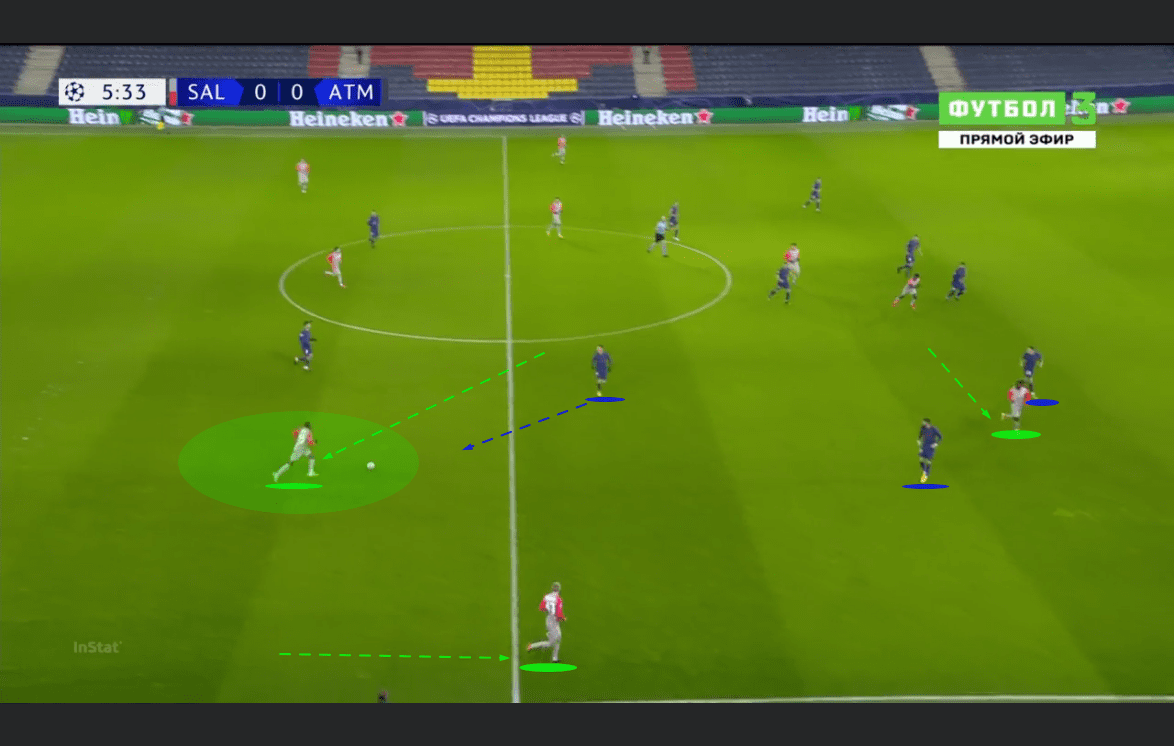
But once Salzburg had time to shift themselves, a free midfielder would arrive in space to create an overload. Once Kristensen was played, Carrasco steps out and creates space behind him. The dropping Daka behind Carrasco could receive in his back and now drag out the full-back which opens up space in behind for Koita, who shifted from the far side to the ball near side. If they could play Koita in behind, Savić had a decisional crisis or he had to run with him and prevent him from entering the centre space but leaving the centre space. Or stay centrally and let him run freely to the goal to an extent but protecting the centre. Both ways would expose the Spanish side at the back.
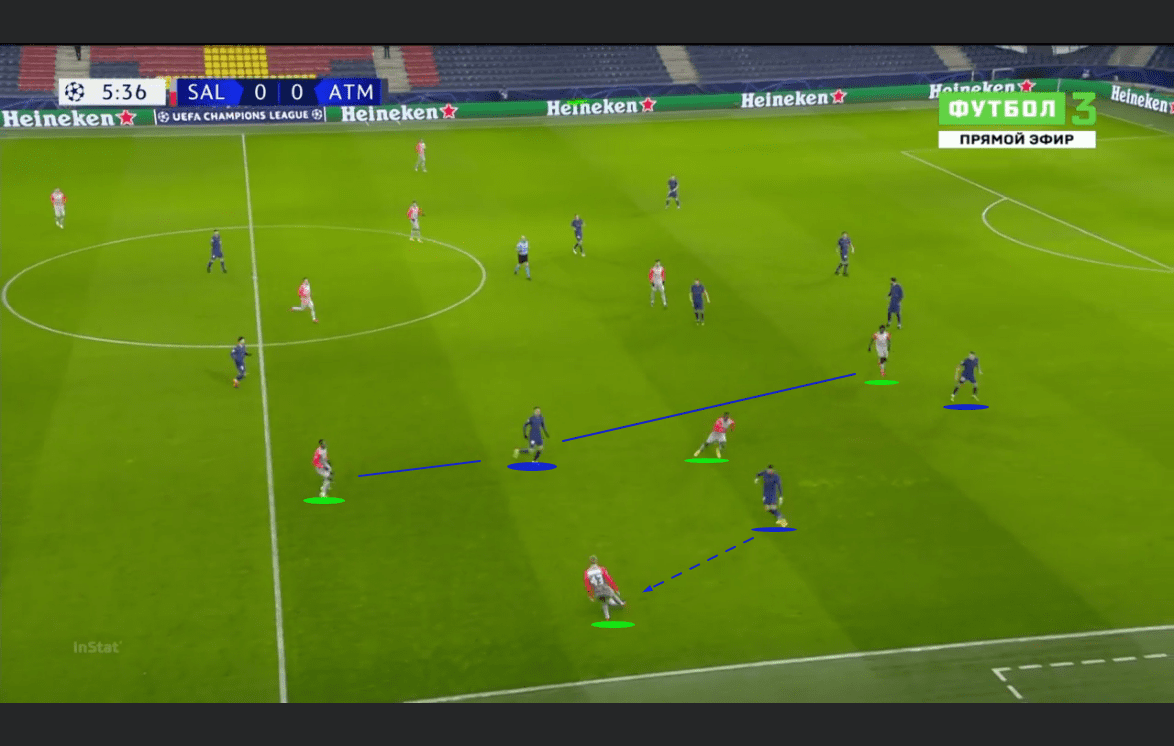
In the below image again another way to make use of the wide superiority. As the Salzburg strikers shifted to the ball near side. One would drop and the other would occupy the last line. Once the ball was on the outside, Daka’s run from deep would attract Carrasco and free the diagonal pass to Koita. Again giving the receiving striker two options, or who could receive in the space between the lines. Or Koita could receive and play a first-time pass to the running Daka, performing a wall pass. All together these offensive tactics led to Salzburg peppering Atleti’s goal with 18 shots.
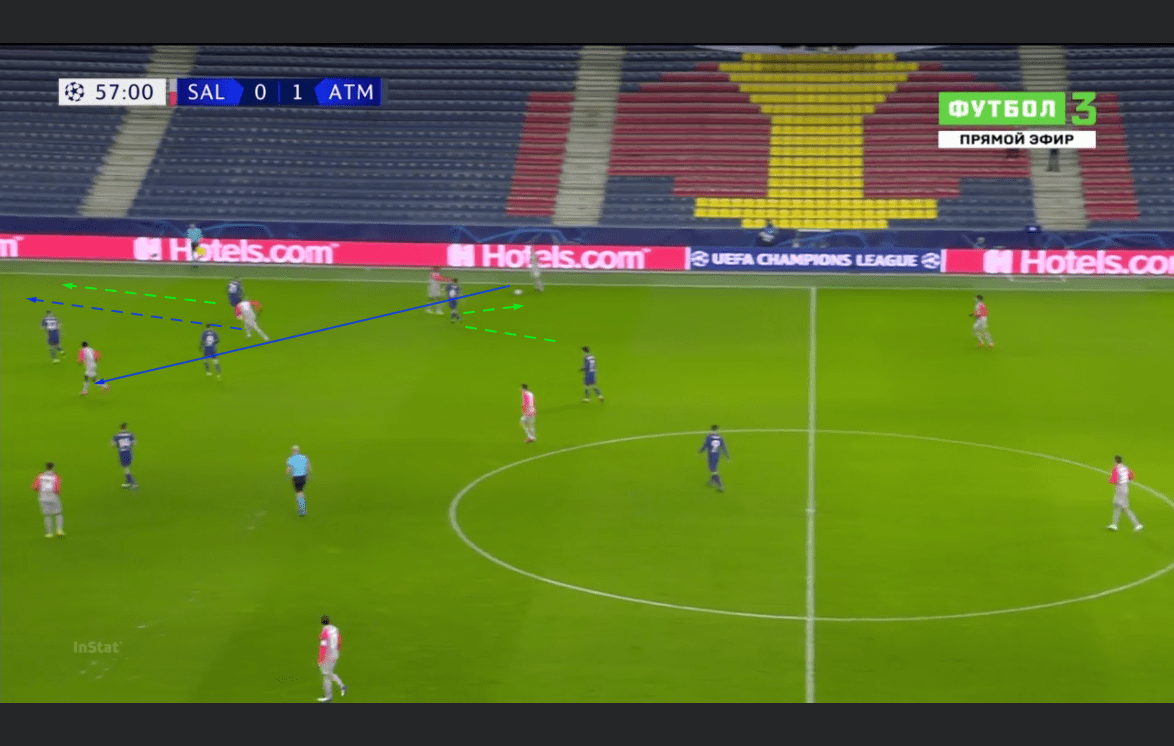
Atletico’s defensive structure prevailing
After following Atletico Madrid under Simeone, we can say that his defensive setup is one of the best in Europe. In this case for Salzburg, it wasn’t easy to progress through the centre.
As described above the dropping Mwepu attracted Koke to press him. Which meant he had to leave the space centrally. Only until late in the second half, the home side looked to take advantage of the space down the centre. Below we can see the earlier described movement and allows a midfielder to receive behind the first the of Atlleti’s press. Especially when his body position would be good, allowing him with his first touch with his face to goal.
Space didn’t only open up centrally because of Koke evacuating central space. But also because of the position of the two strikers, pinning the four defenders. They positioned themselves between the centre-back and full-backs, which gives them difficulties when stepping out to players between the lines. Whilst the other Madrid midfielders mark any Salzburg midfielder in their zone. But as mentioned earlier, Salzburg have an extra midfielder when playing behind the first line press.
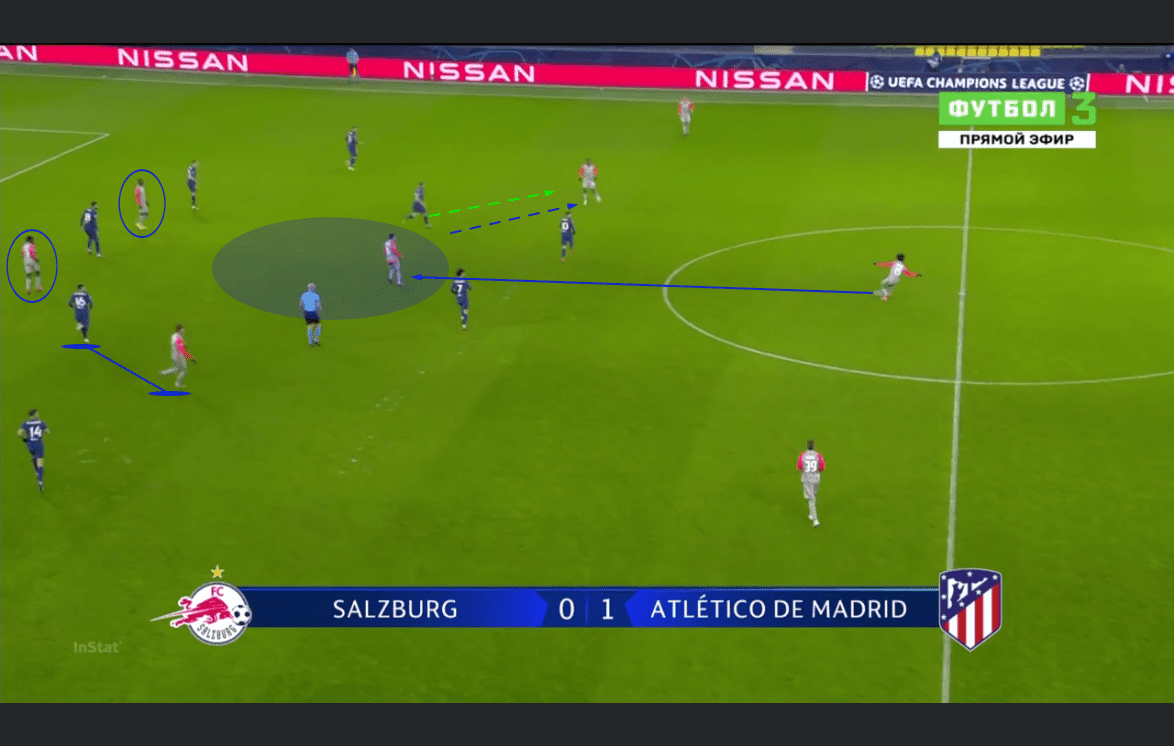
Below shows the problems it would cause Atletico, here the is located between the lines but with the movement of the strikers the defenders are confused and forced out of position. In this occasion, Carrasco is intelligent enough to recognize and drop to the last line and cover Hermoso. This allows the centre-back to step out and deal with any danger of the turning midfielder between the lines.
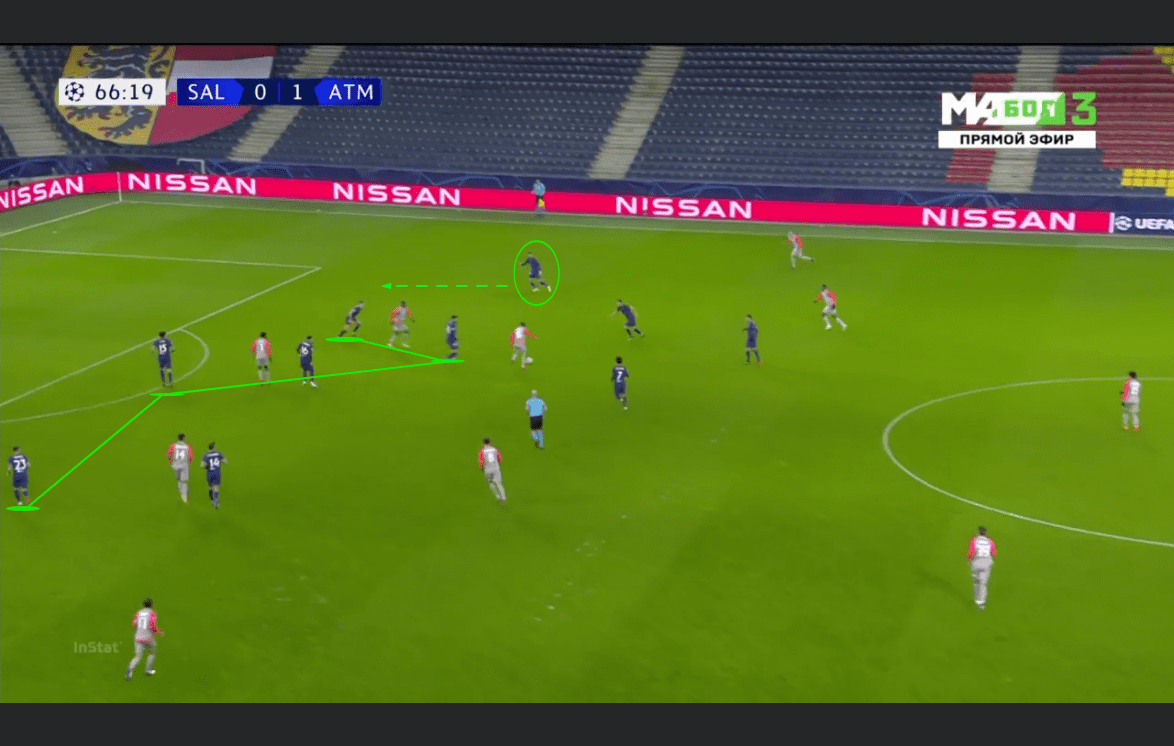
Simeone was quick to recognize the danger Salzburg were causing centrally and switched to a back five. Diego Llorente moved more to the centre. And the left midfielder tucked in. Koke could now step out without worrying about the space he left in between the lines. As two pivots now protected the centre.
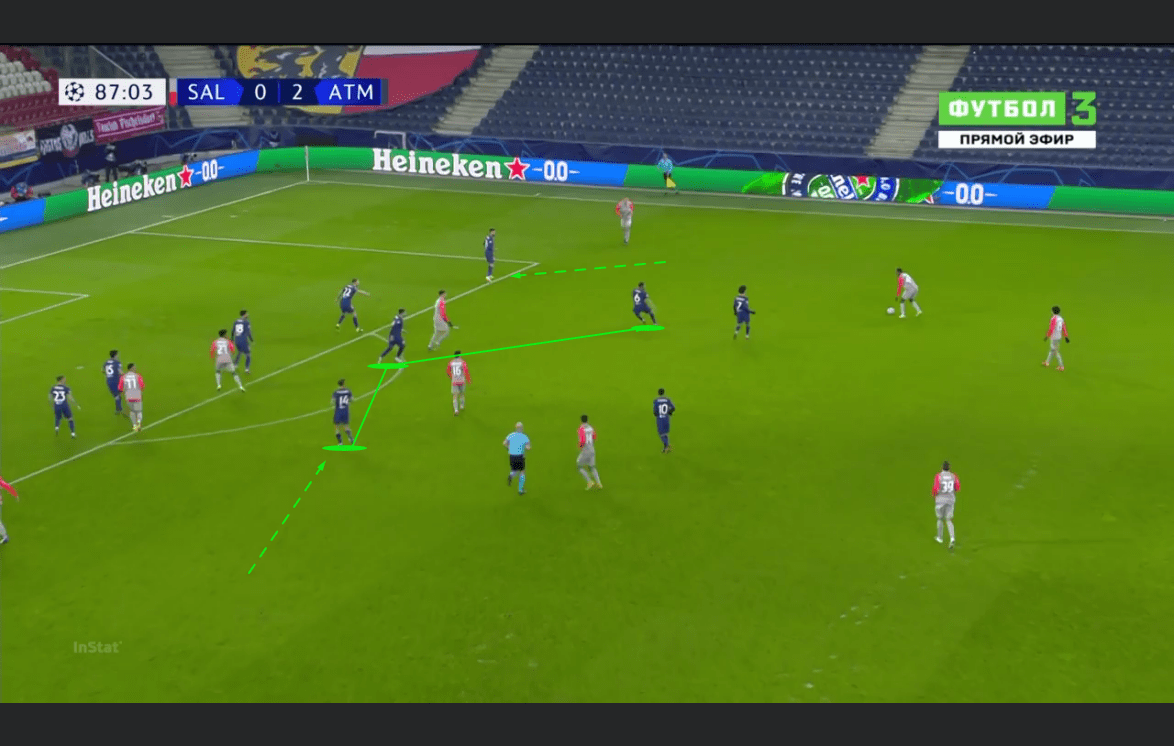
Conclusion
As the game ended in a 0-2 win for Atletico Madrid, Simeone’s men progressed to the next round in the Champions League. The away side didn’t come to entertain, their performance was one that we can expect from a Simeone side over the years.
Although RB Salzburg has to drop down to the Europa League, they didn’t make it an easy pass for the Spanish side. Marsch’s side created chances more, were courageous on and off the ball and deserved at least a point. It was a performance that lacked the cutting edge but one to be proud of. But perhaps Jose Mourinho was right after all: ‘There are lots of poets in football, but poets don’t win titles…’





Comments